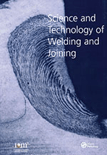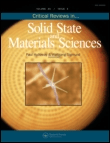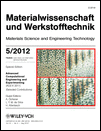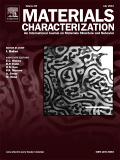
SCIENCE AND TECHNOLOGY OF WELDING AND JOINING
Scope & Guideline
Illuminating the Future of Welding and Joining Research
Introduction
Aims and Scopes
- Welding Processes and Techniques:
Investigates various welding methodologies, such as TIG, MIG, laser welding, and friction stir welding, focusing on their operational parameters, efficiencies, and applications in industrial contexts. - Material Characterization and Performance:
Examines the effects of welding on the microstructural and mechanical properties of materials, including studies on different alloys and composites, assessing their performance under various conditions. - Additive Manufacturing and Advanced Joining:
Explores innovative joining processes, including additive manufacturing approaches, that enhance the capabilities and applications of traditional welding technologies. - Defect Analysis and Quality Control:
Focuses on the identification, analysis, and mitigation of defects in welded joints, employing advanced monitoring and inspection techniques to ensure the integrity and reliability of welds. - Numerical and Experimental Modeling:
Utilizes computational and experimental methods to model welding phenomena, predict outcomes, and optimize welding parameters for better performance and quality.
Trending and Emerging
- Hybrid Welding Techniques:
There is a growing interest in hybrid welding processes that combine multiple methods, such as laser-arc welding, to enhance efficiency and joint quality, reflecting industry demands for improved performance. - Dissimilar Material Joining:
Research focused on the challenges and techniques for joining dissimilar materials is on the rise, driven by the need for innovative solutions in sectors like aerospace and automotive, where multi-material structures are common. - Additive Manufacturing Integration:
The integration of additive manufacturing with traditional welding processes is emerging as a significant area of research, emphasizing the development of new materials and techniques that facilitate advanced manufacturing capabilities. - Smart Welding Technologies:
Emerging themes related to smart technologies in welding, including the use of machine learning and real-time monitoring systems, are gaining traction, reflecting the industry's push towards automation and enhanced quality control. - Sustainability in Welding Practices:
There is an increasing focus on sustainable welding practices, including energy-efficient methods and the use of eco-friendly materials, as industries are pressured to adopt greener technologies.
Declining or Waning
- Traditional Welding Techniques:
Research surrounding conventional welding methods, such as shielded metal arc welding, appears to be decreasing as newer technologies gain prominence and as industries seek more advanced solutions. - Basic Welding Materials Studies:
There is a noticeable reduction in papers solely focused on basic studies of welding materials without the application of advanced techniques or innovative processes, indicating a shift towards more complex and integrative approaches. - Surface Treatment Techniques:
The prevalence of studies centered on surface treatments prior to welding has diminished, possibly due to the growing interest in integrated processes that consider surface preparation as part of the overall welding methodology.
Similar Journals

JOURNAL OF ADHESION SCIENCE AND TECHNOLOGY
Unveiling the Mechanics of Adhesion Technology.Journal of Adhesion Science and Technology is a distinguished publication within the fields of Chemistry, Materials Science, and Engineering, published by the reputable Taylor & Francis Ltd. Since its inception in 1987, the journal has been pivotal in advancing the understanding of adhesion mechanisms, technologies, and applications, boasting a conversion period extending to 2024. With a commendable impact factor and rankings placed in the Q2 category across various relevant domains, including Mechanics of Materials and Materials Chemistry, it offers a robust platform for scholars and practitioners alike. While currently not an open-access journal, it provides multiple access options, ensuring that vital research in adhesion science remains accessible to those dedicated to innovation and practical improvements in material interactions. This journal not only promotes empirical research but also encourages interdisciplinary collaboration, making it essential reading for researchers, industry professionals, and students eager to contribute to this dynamic field.

JOURNAL OF MATERIALS ENGINEERING AND PERFORMANCE
Pioneering Research in Materials EngineeringJOURNAL OF MATERIALS ENGINEERING AND PERFORMANCE, published by Springer, serves as a vital resource for researchers and professionals in the fields of materials science, mechanical engineering, and mechanics of materials. With an ISSN of 1059-9495 and E-ISSN of 1544-1024, this journal boasts a commendable track record since its inception in 1992 and is set to continue providing valuable insights until 2024. Positioned in the Q2 quartile of its categories, the journal is ranked #246 in Mechanical Engineering and #168 in Mechanics of Materials according to Scopus, reflecting its commitment to high-quality research. While currently not adopting an open access model, it remains accessible to academic professionals and students eager to advance their knowledge in the rapidly evolving domain of materials engineering. The scope encompasses innovative research focused on material performance, engineering applications, and technological advancements, making it an indispensable tool for those at the forefront of the field.

Journal of Metals Materials and Minerals
Unveiling Breakthroughs in Materials and Mineral StudiesJournal of Metals Materials and Minerals (ISSN: 0857-6149) is a renowned academic publication dedicated to the interdisciplinary fields of metallurgical science, materials engineering, and mineralogy. Published by Chulalongkorn University, Metallurgy & Materials Science Research Institute in Thailand, this journal serves as a pivotal platform for researchers to disseminate their findings and explore innovative applications related to metals, ceramics, polymers, and biomaterials. Although the journal does not currently adopt an open-access model, it provides insightful content that facilitates knowledge sharing among professionals and academics alike. The journal has established its credibility with impressive Scopus ranking percentiles, particularly in categories such as Metals and Alloys and Ceramics and Composites. With an emphasis on advancing the understanding of materials science from 2017 to 2024, the Journal of Metals Materials and Minerals remains an essential resource for those striving to contribute to and stay informed about the latest trends and breakthroughs in these dynamic fields.

CRITICAL REVIEWS IN SOLID STATE AND MATERIALS SCIENCES
Bridging Theory and Application in Materials ResearchCRITICAL REVIEWS IN SOLID STATE AND MATERIALS SCIENCES, published by Taylor & Francis Inc, is a prestigious journal dedicated to advancing the field of materials science through comprehensive reviews and critical analysis of existing literature. With an ISSN of 1040-8436 and an E-ISSN of 1547-6561, this journal serves as a vital resource for researchers, professionals, and students seeking in-depth understanding of solid-state phenomena and materials applications. Renowned for its high visibility in the academic community, it holds a Q1 ranking across multiple categories including Chemical Engineering, Condensed Matter Physics, and Physical and Theoretical Chemistry, showcasing its impact and relevance in the field. The journal spans its publication years from 1977 to 2024 and is highly regarded, holding prominent positions in Scopus rankings, making it a leading platform for disseminating critical insights and advancing knowledge in materials science. Although it is not an open-access journal, its rigorous peer-review process ensures the highest quality of articles, solidifying its status as a cornerstone for anyone engaged in materials research.

MATERIALWISSENSCHAFT UND WERKSTOFFTECHNIK
Empowering Engineers Through Material Insights.MATERIALWISSENSCHAFT UND WERKSTOFFTECHNIK, published by WILEY-V C H VERLAG GMBH, is a prominent journal dedicated to the field of materials science and engineering. With its ISSN 0933-5137 and E-ISSN 1521-4052, this journal serves as a vital resource for researchers and professionals engaged in exploring the intricate relationships between the properties of materials and their applications. Established in 1970 and continuing through 2024, the journal has been consistently recognized in various categories, achieving a Q3 ranking in 2023 across Condensed Matter Physics, Materials Science (miscellaneous), Mechanical Engineering, and Mechanics of Materials. Although it does not offer open access, its high-quality peer-reviewed content is fundamental to the advancement of knowledge within its three key areas: novel material development, material characterization, and application of materials in engineering contexts. As a driving force in the scientific community, MATERIALWISSENSCHAFT UND WERKSTOFFTECHNIK continues to cater to the curiosity of aspiring students, seasoned professionals, and researchers alike, facilitating a deeper understanding of the complexities of material technology.

Journal of Manufacturing Processes
Unveiling Cutting-edge Research in ManufacturingThe Journal of Manufacturing Processes, published by Elsevier Science Ltd, serves as a premier platform for researchers, professionals, and students engaged in the fields of Industrial and Manufacturing Engineering as well as Management Science and Operations Research. With an impressive Q1 ranking across multiple categories for 2023, this journal not only showcases innovative research but also provides insights into strategic management and operational excellence within the manufacturing sector. Covering an extensive timeline from 1999 to 2024, the journal has solidified its position within the academic community, consistently ranking in the top percentile across various Scopus categories. Although it does not offer open access, the journal maintains a commitment to disseminating high-quality, peer-reviewed research that drives advancements in manufacturing processes. Located in the Netherlands, the journal aims to foster collaboration and knowledge sharing among scholars and industry experts alike, making it an indispensable resource for anyone dedicated to the advancement of manufacturing science.

Advances in Manufacturing
Unleashing Potential Through Cutting-Edge ResearchAdvances in Manufacturing, published by Springer, is a premier journal dedicated to the evolving fields of Industrial and Manufacturing Engineering, Mechanical Engineering, Mechanics of Materials, and Polymers and Plastics. With an impact factor placing it in the Q1 category across multiple disciplines for the year 2023, this journal serves as a vital platform for disseminating cutting-edge research and insights that drive innovation in manufacturing practices. The journal is renowned for its rigorous peer-review process, ensuring that only high-quality studies contribute to the body of knowledge. Spanning the years from 2013 to 2024, it not only publishes papers that advance theoretical frameworks but also those that explore practical applications and case studies in the manufacturing sector. Researchers, industry professionals, and students will find invaluable resources within its pages, fostering collaboration and knowledge exchange within the manufacturing community. This journal is based in the United States, located at One New York Plaza, Suite 4600, New York, NY 10004, and is accessible through various institutional subscriptions.

Journal of Advanced Joining Processes
Advancing the Frontier of Joining TechnologiesJournal of Advanced Joining Processes, published by ELSEVIER, is a pioneering open-access journal dedicated to the dissemination of high-quality research in the field of joining processes, spanning across chemical, mechanical, and materials engineering. With its ISSN 2666-3309, this journal has rapidly established a significant presence in the academic community, achieving Q1 rankings in several categories, including Chemical Engineering, Mechanical Engineering, and Mechanics of Materials, as of 2023. Furthermore, it holds impressive Scopus rankings, with Engineering (miscellaneous) ranked #30 out of 204, indicating its influence and importance within the interdisciplinary landscape of engineering. As an open-access platform since 2020, the Journal of Advanced Joining Processes fosters the free exchange of ideas and research findings, thereby supporting professionals, researchers, and students in advancing their knowledge and practices in cutting-edge joining techniques. With converged years from 2020 to 2024, this journal is poised to remain at the forefront of the evolving field of joining technologies, appealing to a global readership eager to explore innovative solutions and methodologies.

MATERIALS CHARACTERIZATION
Elevating Standards in Materials ResearchMATERIALS CHARACTERIZATION is a leading international journal dedicated to the advancement of knowledge in the field of materials science and engineering. Published by Elsevier Science Inc, this esteemed journal has been disseminating vital research since 1970 and continues to be essential for scholars and industry professionals alike. With an impressive impact reflected in its Q1 quartile rankings across several categories—including Condensed Matter Physics, Materials Science, Mechanical Engineering, and Mechanics of Materials—MATERIALS CHARACTERIZATION stands out as a premier outlet for innovative studies and technical advancements. Researchers can access a wealth of peer-reviewed articles that explore properties, characterization techniques, and applications of materials, fostering interdisciplinary collaboration. With a commitment to high-quality research and comprehensive review processes, the journal plays a crucial role in shaping the future of materials science, making it an invaluable resource for anyone invested in this dynamic field.

JOURNAL OF ENGINEERING MATERIALS AND TECHNOLOGY-TRANSACTIONS OF THE ASME
Pioneering advancements in engineering materials and applications.JOURNAL OF ENGINEERING MATERIALS AND TECHNOLOGY-TRANSACTIONS OF THE ASME is a premier journal published by the American Society of Mechanical Engineers (ASME), dedicated to advancing the field of engineering materials and technology. With an ISSN of 0094-4289 and E-ISSN 1528-8889, this journal has provided invaluable insights since its inception in 1973. Operating from its headquarters in New York, United States, it serves a global audience of researchers, professionals, and students alike. The journal is recognized for its rigorous peer-review process and its commitment to disseminating high-quality research, currently holding a Q3 quartile ranking across multiple categories including Condensed Matter Physics, Materials Science, Mechanical Engineering, and Mechanics of Materials. With a focus on exploring innovative materials and their applications, it aims to foster collaboration and discovery in the engineering community. Although it is not an open-access journal, it continues to play a vital role in shaping the future of engineering materials research up to 2024. Researchers and practitioners will find in this journal a significant platform to support the development and understanding of engineering materials, making contributions that resonate through academia and industry.